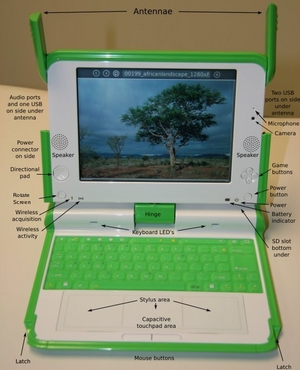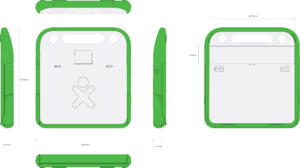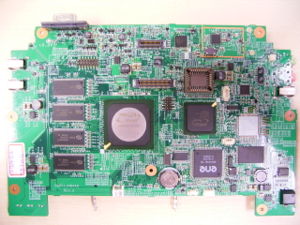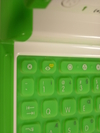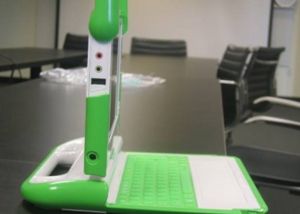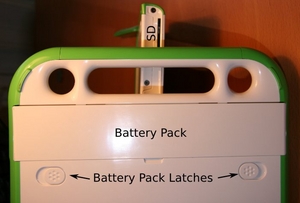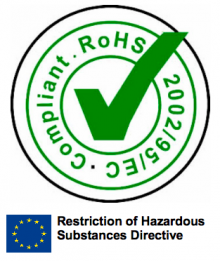Hardware specification
| deutsch | english | español | français | italian | 日本語 | 한글 | português | русский indonesia | HowTo [ID# 298833] +/- |
The XO-1 laptop is a central focus of One Laptop Per Child. After three years of development, it entered mass production in November 2007. There are now millions of units deployed in the field, and thousands more with developers and for testing in schools all over the world. OLPC has developed newer hardware generations XO-1.5 and XO-1.75 that share the XO-1's industrial design.
Specifications
The definitive laptop specification is only available in PDF format. This page attempts to accurately reflect that information. Note: this is the specification of the CL1A XO-1 production laptop. The specification for the earlier CL1 version (with the wide dual-mode touchpad) is here.
Physical dimensions
- Approximate dimensions: 242mm × 228mm × 32mm (see drawing to the right for detailed dimensions)
- Approximate weight:
- XO laptop with LiFePO4 battery: 1.45KG (~3.20lbs);
- XO laptop with NiMH battery: 1.58KG (~3.48lbs);
- Configuration: Convertible laptop with pivoting, reversible display; dirt- and moisture-resistant system enclosure; no fan.
Core electronics
- A photo of the XO-1 motherboard is available, with or without annotations.
- CPU: x86-compatible processor with 64KB each L1 I and D cache; at least 128KB L2 cache;
- Datasheet (dead link)
- CPU clock speed: 433 Mhz;
- i586 instruction set (including MMX and 3DNow! Enhanced) with additional Geode-specific instructions
- Companion chips: PCI and memory interface integrated with CPU;
- Graphics controller: Integrated with CPU; unified memory architecture;
- Embedded controller: ENE KB3700 or ENE KB3700B;
- DRAM memory: 256 MiB dynamic RAM; data rate: dual-DDR333-166Mhz;
- BIOS: 1024KiB SPI-interface flash ROM;
- Open Firmware used to load the operating system;
- Mass storage: 1024 MiB SLC NAND flash; (a few "Red XOs" have been built with 2048 MiB of flash)
- Drives: No rotating media.
- CAFE ASIC (camera- and flash-enabler chip provides high-performance camera, NAND FLASH and SD interfaces); Marvell 88ALP01: CAFE Specification or local copy plus presence detect erratum
Display
- Main article: Display
- Liquid-crystal display: 7.5” dual-mode TFT display;
- Viewing area: 152.4 mm × 114.3 mm;
- Two "modes" depending on lighting conditions:
- (1) Grayscale (B&W) reflective mode: for outdoor use—sunlight-readable; primarily lit from the front by ambient light; high-resolution (200 DPI), 1200(H) × 900(V) grayscale pixels; power consumption 0.1–0.2Watts;
- (2) Color, backlight mode: for indoor use; primarily lit from behind by the LED backlight; built in sub-pixel sampling of the displayed color information results in a perceived resolution of at least 1024(H) × 768(V); power consumption 0.2–1.0Watts;
- The display-controller chip (DCON) with memory that enables the display to remain live with the processor suspended. The DCON also formats data for the display.
- This Liquid-crystal display is the basis of our extremely low power architecture. The XO is usable while the CPU and much of the motherboard is regularly turned off (and on) so quickly that it's imperceptible to the user. Huge power savings are harvested in this way (e.g. by turning stuff on the motherboard off when it's not being used (if even for a few seconds), while keeping the display on).
- Note: web browser images are currently scaled up so that an image of very roughly [800 × 600] fills up the browser window.
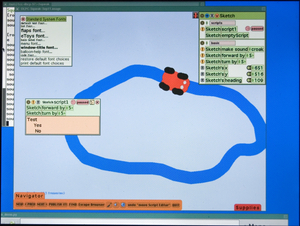
Integrated peripherals
- Keyboard: 80+ keys, 1.0mm stroke; sealed rubber-membrane key-switch assembly;
- Keyboard Layouts
- Layout pictures: English, Arabic, Thai, West African (Nigeria), Portuguese, Spanish, Amharic, French, Urdu, Cyrillic, Turkish (not final), Nepali, Mongolian, Kazakh, Devanagari, Uzbek, Pashto, Dari, Pulaar (Fula), Italian
- Gamepad: Two sets of four-direction cursor-control keys;
- Touchpad: Capacitance touchpad
- ALPS Electric Dual capacitance/resistive touchpad;
- Audio: AC’97 compatible audio subsystem; Internal stereo speakers and amplifier; internal monophonic microphone; jacks for external headphones or microphone;
- Analog Devices AD1888 and Analog Devices SSM2302 for audio amplification
- Camera: integrated color video camera; 640 x 480 resolution at 30 FPS; independent (and undefeatable by software) display of microphone and camera recording status; the camera and device driver support disabling AGC and automatic color balancing, to enable its use as a photometric sensor for educational applications;
- Wireless Networking: Integrated 802.11b/g (2.4GHz) interface; 802.11s (Mesh) networking supported; dual adjustable, rotating antennas support diversity reception; capable of mesh operation when CPU is powered down;
- Status indicators: Power, battery, and WiFi (2), visible with lid open or closed; Microphone In-Use, and Camera In-Use, visible when lid is open.
External connectors
- DC power: 6mm (1.65mm center pin) connector; 11 to 18 V input usable, –32 to +40V input tolerated; power draw limited to 17 W; - see power connector dimensions at Battery and power.
- Headphone output: standard 3.5mm 3-pin switched stereo audio jack;
- Microphone input: standard 3.5mm 2-pin switched mono microphone jack; selectable 2V DC bias; selectable sensor-input mode (DC or AC coupled);
- USB: Three Type-A USB 2.0 connectors; Up to 1A power supplied (total);
- Flash Expansion: SD Card slot.
Battery
- Pack type: 2 or 4 cells LiFePO4; or 5 cells NiMH, approx. 6V series configuration (subject to change);
- Capacity: 16.5 Watt-hours (NIMH), 22 Watt-hours (LiFeP);
- Fully-enclosed “hard” case; user removable;
- Electronics integrated with the pack provide:
- Identification;
- Battery charge and capacity monitoring chip (Maxim DS2756 data sheet);
- Thermal and over-current sensors along with cutoff switch to protect battery;
- Minimum 2,000 charge/discharge cycles (to 50% capacity of new).
- Power Management will be critical
See Laptop Batteries or more information.
BIOS/loader
- Open Firmware (including hardware initialization and fast resume).
- Panasonic ML1220 battery
Environmental specifications
- Temperature: UL certification planned to 45C in Q32007, pending 50C certification in mid-2008;
- Humidity: UL certification planned to IP42 (perhaps higher) when closed, the unit should seal well enough that children walking to and from school need not fear rainstorms and dust;
- Maximum altitude: –15m to 3048m (14.7 to 10.1 PSIA) (operating), –15m to 12192m (14.7 to 4.4 PSIA) (non-operating);
- Shock 125g, 2ms, half-sine (operating) 200g, 2ms, half-sine (non-operating);
- Random vibration: 0.75g zero-to-peak, 10Hz to 500Hz, 0.25 oct/min sweep rate (operating); 1.5g zero-to-peak, 10Hz to 500Hz, 0.5 oct/min sweep rate (nonoperating);
- 2-3mm plastic walls (1.3mm is typical for most systems).
Regulatory requirements
- The usual US and EU EMI/EMC (electromagnetic-interference and electromagnetic-compatibility) requirements will be met;
- The laptop meets IEC 60950-1, EN 60950-1, and CSA/UL 60950-1 specifications. It also complies with UL 1310 and UL 498. In order to guarantee the safety of children using the laptop, it passes ASTM F 963;
- The external power adapter complies with IEC, EN, and CSA/UL 60950-1;
- The removable battery pack complies with IEC, EN, and CSA/UL 60950-1 and UL 2054;
- RoHS (Restriction of Hazardous Substances Directive – EU) compliant.
Laptop Development Schedule
On April 15, 2006, the first prototypes of the XO, the A1 prototype boards, were first powered on. Development continued with the B1, the first complete prototype laptop, in November of 2006. The B2 laptops were the first to incorporate the CaFE chip, and was produced in small quantities for initial trials in January 2007. In April of 2008 the design was refreshed with a faster processor and more memory/NAND flash. The B3 prototypes were the first test of this design. Slight refinements were incorporated into the B4, manufactured in June 2008, which is very similar to the production version of the laptop. Finally, mass production started in November 2007 with the C2 version.
Each prototype and production version is described in more detail separately: A1, B1, B2, B3, B4, C1, C2
Serial Adapter
In order to conserve parts/space, while the motherboard does provide two serial ports for debugging (one populated in production), it does not provide voltage translators to fully implement the RS-232 protocol. Thus a 3.3V TTL to RS-232 (or USB) Adapter is needed.
Other Documents
- A complete Repair Parts List is under development.
- Schematics
See also
Formerly part of this page:
See also:
- Hardware Testing: Safety Certifications and Robustness
- Hardware
- Support
- The definitive laptop specification (only available in PDF format).
